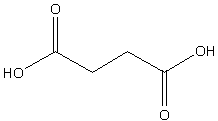
When succinic acid is heated, product formed is:
A. Succinic anhydride
B. Acetic acid
C. CO2 and methane
D. Propionic acid
Answer
224.4k+ views
Hint: Succinic acid is a carboxylic acid comprising two carboxylic acids. It is depicted by the chemical formula of \[{{\rm{C}}_{\rm{4}}}{{\rm{H}}_{\rm{6}}}{{\rm{O}}_{\rm{4}}}\] . Its production is done from liquefied petroleum gas. Also, the production of succinic is done from different microbes as petroleum gas is very expensive.
Complete step by step answer:
The structure of succinic acid is,

Image: Succinic acid
The above structure clearly shows that the structure is of cis form and there is the existence of a dipole moment.
Let's understand the product gives on heating of succinic acid. The heating of succinic anhydride gives the product of succinic anhydride. And in this process, the loss of a water molecule takes place. The chemical reaction is as follows:

Image: Heating of succinic anhydride
Additional Information:
Succinic acid belongs to the group of carboxylic acids. It is one of the common organic acids. It is useful in industries such as chemical, food, and pharmaceutical for the production of many substances such as perfumes, plasticizers, solvents, and photographic chemicals. It is also helpful in the form of antibiotics. It possesses the property of softening skin and bacteria-inhibiting properties.
Note: To prepare succinic acid, the method that is most commonly used is the catalytic hydrogenation of maleic acid or its anhydride. There are some other methods which are also used for the same. Succinic acid occurs in nature in the form of crystalline solids of no colour. It is soluble in water.
Complete step by step answer:
The structure of succinic acid is,

Image: Succinic acid
The above structure clearly shows that the structure is of cis form and there is the existence of a dipole moment.
Let's understand the product gives on heating of succinic acid. The heating of succinic anhydride gives the product of succinic anhydride. And in this process, the loss of a water molecule takes place. The chemical reaction is as follows:

Image: Heating of succinic anhydride
Additional Information:
Succinic acid belongs to the group of carboxylic acids. It is one of the common organic acids. It is useful in industries such as chemical, food, and pharmaceutical for the production of many substances such as perfumes, plasticizers, solvents, and photographic chemicals. It is also helpful in the form of antibiotics. It possesses the property of softening skin and bacteria-inhibiting properties.
Note: To prepare succinic acid, the method that is most commonly used is the catalytic hydrogenation of maleic acid or its anhydride. There are some other methods which are also used for the same. Succinic acid occurs in nature in the form of crystalline solids of no colour. It is soluble in water.
Recently Updated Pages
JEE Mains 2026: Exam Dates and City Intimation slip OUT, Registration Open, Syllabus & Eligibility

JEE Main Candidate Login 2026 and Registration Portal | Form Access

JEE Main 2026 Session 1 Correction Window Started: Check Dates, Edit Link & Fees

JEE Isolation, Preparation and Properties of Non-metals Important Concepts and Tips for Exam Preparation

Isoelectronic Definition in Chemistry: Meaning, Examples & Trends

Ionisation Energy and Ionisation Potential Explained

Trending doubts
Understanding Electromagnetic Waves and Their Importance

Half Life of Zero Order Reaction for JEE

Understanding Displacement and Velocity Time Graphs

Understanding How a Current Loop Acts as a Magnetic Dipole

Which of the following will not undergo H V Z reaction class 12 chemistry JEE_Main

JEE Main 2026 Exam Date (OUT): Session 1 and 2 Schedule, Registration and More

Other Pages
JEE Advanced 2026 - Exam Date (Released), Syllabus, Registration, Eligibility, Preparation, and More

JEE Advanced 2026 - Exam Date (Released), Syllabus, Registration, Eligibility, Preparation, and More

CBSE Class 12 Chemistry Question Paper Set 3 2025 with Answers

Understanding Inertial and Non-Inertial Frames of Reference

An alcohol A gives Lucas test within 5 minutes 74 g class 12 chemistry JEE_Main

New Year's Day 2026: Significance, History, and How to Celebrate in India




